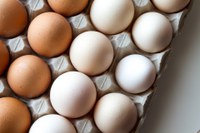Prairie Fare: Eggs Are All They Are Cracked Up to Be
(Click an image below to view a high-resolution image that can be downloaded)
By Julie Garden-Robinson, food and nutrition specialist
NDSU Extension
“Do you want a bagel with scrambled eggs and cheese?” my neighbor asked.
Of course, I did.
Scrambled eggs are one of my favorite foods starting from when I was a toddler.
My neighbor and I were going shopping that morning. Eggs were just the ticket for sustained energy.
However, that energy boost may have affected how much I purchased. I zipped around several stores with my cart and kept finding things I liked.
We had lunch later, and I had no problem taking half of my lunch home. I was still full from breakfast.
Researchers have shown that having eggs for breakfast may reduce the amount of food we eat later in the day. A study published in 2020 examined the effects of two different breakfast meals on later hunger for 50 overweight or obese participants.
The study participants’ meal choices were eggs and toast, or toast with cereal and milk. Those who had high-quality protein such as eggs in the morning reduced their food consumption at lunch compared with higher-carbohydrate meals such as cereal.
However, if you are on a special diet, be sure to work with your healthcare provider.
In my work I often am asked about eggs. How would you answer these questions that I have received through the years?
1. “My eggs expired two days ago according to the date on the carton. Is it safe to use the eggs?
2. “Why did my hard-boiled eggs turn green around the yolk?”
3. “I have a recipe for ice cream that calls for raw eggs. Will freezing kill the bacteria?”
These are the answers based on national safety recommendations.
1. Yes, fresh eggs are safe to use for three to five weeks after you purchased them, according to the U.S. Department of Agriculture. The date on the carton is usually a sell-by date for the store.
For safety and quality, eggs should be kept refrigerated. In fact, stores and restaurants must receive eggs at their door at a temperature of 45 degrees Fahrenheit.
2. The green halo on hard-cooked eggs is due to a natural reaction between the iron in egg yolk and the sulfur in the egg white. It is not harmful but is not very attractive in your deviled eggs.
Note that I called them “hard-cooked” eggs. Prolonged boiling promotes the green color.
The Egg Board recommends placing eggs in a saucepan in a single layer. Add cold water to cover by 1 inch, then heat over high heat just to boiling. Remove from the heat and cover the pan. Allow to stand in hot water for 12 minutes for large eggs. Drain and serve warm, or cool completely in ice water.
Other people create perfect eggs in an “egg pod” appliance or in a multifunction cooker. Follow the manufacturer’s directions.
3. Eating raw or undercooked eggs poses a safety risk. Freezing doesn’t kill bacteria such as salmonella. Either find a recipe that does not call for raw eggs, or replace the raw eggs with pasteurized eggs available in the shell or in liquid form.
I sometimes am a lucky recipient of farm-fresh eggs from friends that raise chickens. In many cities, you can raise your own backyard chickens if you follow the city ordinances.
If you are inspired, a group of NDSU Extension agents and specialists created a new guide called the “Beginners Guide to Raising Chickens.” Search for that title to learn more.
Lately, we have been hearing about “bird flu” that can affect poultry. “Bird flu,” known as avian influenza, is not a food safety issue, and poultry is safe to eat. Always cook poultry and eggs thoroughly. Be aware of state and federal guidance and updates. See www.cdc.gov/flu/avianflu/avian-flu-summary.htm for details.
Are you hungry for a breakfast dish that also works for any meal of the day?
Sausage, Egg and Cheese Breakfast Bake
16 ounces hash browns, fresh or frozen (thawed)
Salt (optional)
12 ounces breakfast sausage links, cut into chunks (or chopped ham)
1/2 cups onion, chopped
1/2 cups red bell pepper, chopped
2 cups colby-jack or cheddar cheese (low-fat or fat-free), shredded
6 eggs
1/2 cup milk, fat-free or low-fat
1/2 teaspoon black pepper
Preheat oven to 350 F. Thaw hash browns in a microwave oven if needed. Cut links into small pieces, then brown sausage in a frying pan. Add onion and pepper to the pan and saute until softened. Set aside. Spray a 9- by 9-inch casserole dish. Spread half of the hash browns in the pan. If desired, sprinkle potatoes lightly with salt.
Top the potatoes with half of the sausage, onion and pepper mixture. Top with 1 cup of shredded cheese. Repeat layers. Sprinkle the top with remaining cheese. Whisk together eggs, milk and seasonings. Pour egg mixture over the layers and swirl gently to penetrate layers. Bake for 30 to 35 minutes or until eggs are set and temperature reaches 160 F.
Makes six servings. Each serving has 340 calories, 16 grams (g) fat, 30 g protein, 18 g carbohydrate, 2 g fiber and 720 milligrams sodium.
(Julie Garden-Robinson, Ph.D., R.D., L.R.D., is a North Dakota State University Extension food and nutrition specialist and professor in the Department of Health, Nutrition and Exercise Sciences. Follow her on Twitter @jgardenrobinson)
NDSU Agriculture Communication – March 31, 2022
Source: Julie Garden-Robinson, 701-231-7187, julie.garden-robinson@ndsu.edu
Editor: Elizabeth Cronin, 701-231-5391, elizabeth.cronin@ndsu.edu




